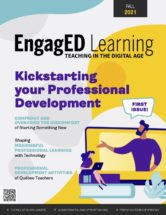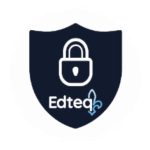This article is part of
Vol. 1, issue 1 (Fall 2021)
of EngagED Learning magazine.
By Craig Bullett, Pedagogical Consultant for LEARN and the RÉCIT Provincial Service for the Anglophone Community
The LEARN Pedagogical Services team, with some local RÉCIT collaborators, have been throwing around ideas to better understand the Digital Competency Framework (DCF). They have been drilling down into the 12 dimensions and trying to articulate their place within respective subject areas. As they struggled to make authentic connections with the teaching practices, they realized that both teachers and students are experiencing the same obstacles.
It was clear that they needed a more practical way to learn, understand and adopt the DCF. And, who knows….perhaps it could even be fun!
They decided to take an informal direction by making connections to the DCF, as it applies to a hobby, craft or leisure activity. The outcomes were very interesting and included dance, real-estate, baking bread, snooker, and creative writing. They hope their experiences can shed light on understanding the DCF and inspire others to try the activity with colleagues and students.
What is the DCF?
To paraphrase the Ministère de l’Éducation du Québec (MEQ), the Digital Competency Framework is intended to help all Quebecers develop digital skills to become more confident, critical and creative in our daily lives, (DCF, p. 7).
The Process for the Activity
They invited the consultants to join a collaborative slide deck and claim one slide to use for their individual reflection. Each slide contained a blank template containing the 12 dimensions of the digital competency. The center of the slide contained a blank box for participants to enter any craft, hobby, or leisure activity. In other words, anything they would consider non-academic.
Participants were asked to quickly populate one or two of the dimensions on their respective slides and then share back with the group. The purpose was to expose the dimensions which immediately come to mind, to get them out of the way, and warm up our thinking. The deeper intention was to get beyond the most used dimensions and address those which are more difficult to contextualize. At the end of the session, participants had homework to complete the slides and percolate their understanding.
For sure, everybody can’t be mindful of every dimension in every learning situation. However, it is important to articulate a few of them each time. Some of the shared samples do elaborate on several of the dimensions. The knitting example was able to address all 12. This particular sample aims to provide a great starting point to help anyone better assimilate digital competency.
Take a crack at the exercise with some colleagues or students and see how things emerge for you. Since the participants will be the most knowledgeable of their chosen hobby, it will help them to dig a little deeper by addressing dimensions beyond the one or two they typically fall back on.
12 Dimensions of Knitting: An Example
For the purposes of this article, the knitting example emerged as the most comprehensive. In fact, the knitting example is used as a launching point to help subsequent groups move forward in applying the DCF to their own hobby. It helps demonstrate that the DCF could be applied to a leisure activity, not necessarily related to education.
So, the table below highlights a description of the digital competency applied to knitting. It is a personal example of how the competency would be applied an individual’s hobby. As mentioned, you could recreate the same exercise with another activity. An overarching question is also identified for each of the 12 dimensions. These questions can provide guidance for those who try the activity with colleagues or students.
| 1. Exercising ethical citizenship in the digital ageWhere did your information come from and what are you sharing?Respecting copyright for patterns. (E.g.: No posting of commercial patterns, no commercializing products using copyrighted patterns without permission.) Awareness of where materials come from, reuse of unused materials. |
| 2. Developing and mobilizing technological skillsWhat tech tools, apps, platforms, and interfaces did you use?Creation of charts using apps and online tools. E.g.: stitchfiddle.com |
| 3. Harnessing the potential of digital resources for learningWhat helped you to learn more about your topic?Using online classes, videos, and blogs to learn new techniques. E.g. https://www.craftsy.com/ |
| 4. Developing and mobilizing Information LiteracyHow did you know your sources were reliable?Finding the best sources of technical information, research, related Twitter feeds, and newslettersManaging information – bookmarks, apps, photos, patterns |
| 5. Collaborating via digital technologyWho helped you in the learning process?Online knitting clubs – forums, Zoom clubs, culture of community projects – knitting hats for preemies, blankets, mittens |
| 6. Communicating via digital technologyWho did you interact with to learn about your topic?Community forums and platforms such as www.ravelry.com, Knitting Paradise, pattern reviews, comments on projects. |
| 7. Producing Content via digital technologyWhat did you create to demonstrate your learning?Documentation of projects in progress and finished pieces. Blogs, sites and online communities to share work. Links between knitting and coding:– Chart design– Scratch/MB project– Knitting touch pads with conductive yarn |
| 8. Using digital tools to foster inclusion and address diverse needsWhat are some obstacles which you or other learners may encounter?Adapted tools and methods for people with limited dexterity. Charts vs written patterns. Continental vs English methods. Guidelines for Transcribing Knit and Crochet Patterns, 2014 |
| 9. Mobilizing digital technology for personal and professional empowermentHow did this experience contribute to your skill-set?RWT Art practice – Link between coding and textiles.Advocacy for creative computing, makerspaces, coding as creation, and role of the arts in tech.Advanced Textiles Research Group. Contemporary fiber artists. |
| 10. Solving diverse problems via digital technologyHow did you overcome obstacles?Troubleshooting mistakes – YouTube videos, blogs, forumsConversions for patterns, sizes, needles, techniques – various apps such as Knitting Genius, My Row Counter, Counter, Bellish. |
| 11. Developing critical thinking with regards to the use of digital technologyHow did you determine what was useful to help you learn?Selecting reputable sources for supplies and patterns. Reading reviews on non-sponsored sites. Selecting appropriate apps – ad-free, non-commercial, etc.How is info being used and shared? Comparing different approaches. |
| 12. Adopting an innovative and creative approach to the use of digital technologyHow did you go beyond what you learned and put your personal touch on the topic?Getting inspiration: https://www.knitsonik.com Designing patterns based on digital sound recordings – Elisabetta Matsumoto, Georgia Tech – Parabolic knitting – Online exhibits and archive |
The LEARN Ped team hopes this activity provides a starting place to jump into digital competency for your teaching practices. The next step will be to transition from a non-academic example and to articulate how digital competency applies in all other academic subjects.
Resources
Digital Competency in Action: Slide Deck (featured image is in Slide #3)
Digital Competency: 12 Questions (PDF Document available at : https://monurl.ca/12questions)
Bullet, C. (2020, Oct. 19). Understanding and Applying the Digital Competency Framework. Learn. bit.ly/understandingDCF
Compare 9 CCCs and DCF dimensions: bit.ly/DCFandCCC
Bullett, C. (2020, Jan 22). Intro to Digital Competency Framework (DCF) for Students. . bit.ly/DCFintrostudent
Dimensions with description and examples: bit.ly/DCFanimatedwheel
Bullett, C. Digital Competency Framework Ressources. http://bit.ly/DCFresources
===
The original text was published on the LEARN Blog: https://blogs.learnquebec.ca/2021/02/how-to-knit-a-template-for-digital-competency/












